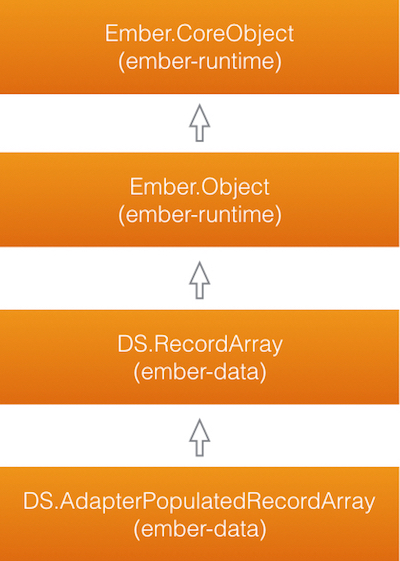Recently I was in a situation where I had a list of Ember Data records and I wanted to write a unit test for a computed property in my controller that returned the most recent record. My model hook called query on the store for all cat objects:
export default Ember.Route.extend({
model() {
return this.store.query('cat', {
alive: true,
});
},
});When I went to write my test for this computed property, I wasn't sure how to set up my fixture data. The model in the controller wasn't a regular array. If you call query on the store, you get an instance of DS.AdapterPopulatedRecordArray. Similarly, if you call findAll on the store, you get an instance of DS.RecordArray. You can find out the type of object you are dealing with by calling toString() on the model.
export default Ember.Route.extend({
model() {
return this.store.query('cat', {
alive: true,
});
},
afterModel(model) {
console.log(model.toString()); // <DS.AdapterPopulatedRecordArray:ember363>
},
});So I started wondering, how do you create test fixtures using these types to simulate what you'd get from the route? My first thought was to manually create an instance of DS.AdapterPopulatedRecordArray. Seemed reasonable, but I didn't find much in the documentation on how to do that. After a few failed attempts, I figured that wasn't the way to go. Then I clicked on the class it extended from DS.RecordArray and noticed that it states:
A record array is an array that contains records of a certain type. The record array materializes records as needed when they are retrieved for the first time. You should not create record arrays yourself. Instead, an instance of DS.RecordArray or its subclasses will be returned by your application's store in response to queries.
That eliminated the first two options. After some digging and thanks to Jason Mitchell on Ember Discussion Forum, I was pointed to Ember.ArrayProxy. Turns out that both DS.AdapterPopulatedRecordArray and DS.RecordArray extend from Ember.ArrayProxy. This is the full class hierarchy:

With that, I was able to write my unit test by simulating DS.AdapterPopulatedRecordArray with an Ember.ArrayProxy.
test('it shows the latest cat added to my family', function (assert) {
var controller = this.subject();
controller.set(
'model',
Ember.ArrayProxy.create({
content: [
Ember.Object.create({
id: 1,
name: 'Tubby',
adopted_at: new Date('2015-09-25T21:44:24.6496202Z'),
}),
Ember.Object.create({
id: 2,
name: 'Biscuit',
adopted_at: new Date('2015-10-21T23:30:54.217Z'),
}),
Ember.Object.create({
id: 3,
name: 'Chester',
adopted_at: new Date('2015-09-29T21:37:33.1677559Z'),
}),
Ember.Object.create({
id: 4,
name: 'Fiona',
adopted_at: new Date('2015-10-07T19:24:36.763Z'),
}),
],
})
);
assert.equal(controller.get('mostRecentAdoptedCat.name'), 'Biscuit');
});Each element in the Ember.ArrayProxy is an Ember.Object simulating the cat model. Here is the implementation of the mostRecentAdoptedCat computed property:
export default Ember.Controller.extend({
mostRecentAdoptedCat: Ember.computed('model', function () {
return this.get('model').sortBy('adopted_at').reverseObjects().objectAt(0);
}),
});Edit
Thanks to Andrey and Jakub in the comments, I've learned you can simply use a regular array instead of an Ember.ArrayProxy. If prototype extensions are enabled, which they are by default, Ember extends Array.prototype with a mixin Ember.Array. As noted in the API documentation:
This mixin implements Observer-friendly Array-like behavior. It is not a concrete implementation, but it can be used up by other classes that want to appear like arrays.
Ember.ArrayProxy also uses the Ember.Array mixin. If you have turned off prototype extensions, then you simply use Ember.A to create your array. The test can be revised to the following:
test('it shows the latest cat added to my family', function (assert) {
var controller = this.subject();
controller.set('model', [
Ember.Object.create({
id: 1,
name: 'Tubby',
adopted_at: new Date('2015-09-25T21:44:24.6496202Z'),
}),
Ember.Object.create({
id: 2,
name: 'Biscuit',
adopted_at: new Date('2015-10-21T23:30:54.217Z'),
}),
Ember.Object.create({
id: 3,
name: 'Chester',
adopted_at: new Date('2015-09-29T21:37:33.1677559Z'),
}),
Ember.Object.create({
id: 4,
name: 'Fiona',
adopted_at: new Date('2015-10-07T19:24:36.763Z'),
}),
]);
assert.equal(controller.get('mostRecentAdoptedCat.name'), 'Biscuit');
});This feels much more natural!
Summary
In your unit tests you can often times use a standard array as a substitute for an array-like object from the store, such as DS.AdapterPopulatedRecordArray or DS.RecordArray, because Ember extends both with the Ember.Array mixin.

